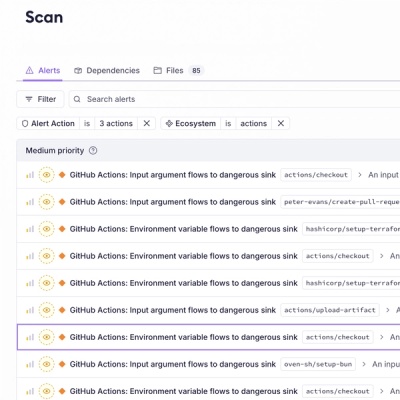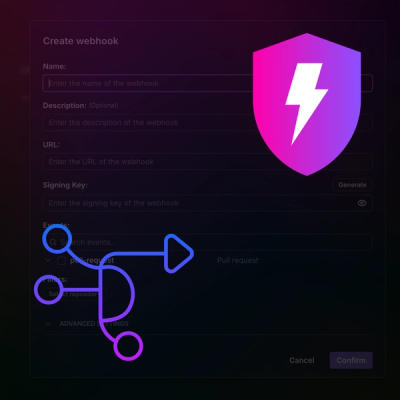
Product
Introducing GitHub Actions Scanning Support
Detect malware, unsafe data flows, and license issues in GitHub Actions with Socket’s new workflow scanning support.
strapi-plugin-multi-tenant
Advanced tools
A Strapi plugin to make Strapi a full-fledged backend for your SaaS
To install this plugin, you need to add an NPM dependency to your Strapi application.
# Using Yarn
yarn add strapi-plugin-multi-tenant
# Or using NPM
npm install strapi-plugin-multi-tenant
The plugin adds Organization and UserGroup content types. Also, it provides middleware and policies that keep data isolated between tenants.
Organization is a single business entity—for example, Google or Microsoft.
UserGroup is a group of users within an Organization. Most commonly, it's a department name, such as Engineering or Product, or a geographical division like Microsoft EMEA and Microsoft APAC. This model lets you isolate content within a tenant. For example, Engineering need not have access to Product content. If you don't need such granularity, create a single UserGroup per Organization. UserGroups can optionally create a hierarchy. For example, Acme HQ could have Acme Engineering and Acme Product as its immediate children. Acme Engineering could contain Frontend, Backend, and DevOps UserGroups. In this scenario, every User assigned to Engineering has access to content from Engineering and Frontend, Backend, and DevOps.
A User (from users-permissions plugin) can only belong to one UserGroup.
The plugin comes with two ways to isolate data: a policy that only lets users change resources that belong to their UserGroup, and a middleware that enforces creating and fetching resources for their UserGroup. See the section below for usage.
Let's consider an example. Acme Inc created a SaaS using Strapi as a backend. The application lets companies add notes and organize them into workspaces. Users should only have access to their department's workspaces.
./config/plugins.js
module.exports = ({ env }) => ({
// ...
"multi-tenant": {
enabled: true,
},
// ...
});
Then, you'll need to build your admin panel:
# Using Yarn
yarn build
# Or using NPM
npm run build
Workspace can contain many Notes. A workspace belongs to a single UserGroup.
{
"kind": "collectionType",
"collectionName": "workspaces",
"info": {
"singularName": "workspace",
"pluralName": "workspaces",
"displayName": "Workspace"
},
"options": {
"draftAndPublish": false
},
"pluginOptions": {},
"attributes": {
"name": {
"type": "string"
},
"notes": {
"type": "relation",
"relation": "oneToMany",
"target": "api::note.note",
"mappedBy": "workspace"
},
"userGroup": {
"type": "relation",
"relation": "manyToOne",
"target": "plugin::multi-tenant.user-group",
"inversedBy": "workspaces"
}
}
}
Note schema:
{
"kind": "collectionType",
"collectionName": "notes",
"info": {
"singularName": "note",
"pluralName": "notes",
"displayName": "Note"
},
"options": {
"draftAndPublish": true
},
"pluginOptions": {},
"attributes": {
"text": {
"type": "text"
},
"workspace": {
"type": "relation",
"relation": "manyToOne",
"target": "api::workspace.workspace",
"inversedBy": "notes"
}
}
}
For routes that contain a resource ID, such as GET, PUT or DELETE /workspaces/:id, add plugin::multi-tenant.is-same-user-group to their route config.
Example configuration for Workspace router:
{
name: "plugin::multi-tenant.is-same-user-group", // plugin name
config: {
contentType: 'api::workspace.workspace' // which content type the route is for
}
}
That's it! Use the same configuration for GET, PUT and DELETE /workspaces/:id.
/**
* workspace router
*/
import { factories } from "@strapi/strapi";
const sameUserGroupPolicyConfig = {
name: "plugin::multi-tenant.is-same-user-group",
config: {
contentType: "api::workspace.workspace",
},
};
export default factories.createCoreRouter("api::workspace.workspace", {
config: {
update: {
policies: [sameUserGroupPolicyConfig],
},
delete: {
policies: [sameUserGroupPolicyConfig],
},
findOne: {
policies: [sameUserGroupPolicyConfig],
},
},
});
Note does not contain a relation to a UserGroup, but we still want to secure the resource. There are two ways to solve this problem: denormalize Note also to include a relation to a UserGroup, or configure the policy like so:
{
name: "plugin::multi-tenant.is-same-user-group",
config: {
contentType: 'api::note.note',
attribute: 'workspace' // let the policy know which attribute to check for a relation with a UserGroup
}
}
Complete config for Note:
/**
* note router
*/
import { factories } from "@strapi/strapi";
const sameUserGroupPolicyConfig = {
name: "plugin::multi-tenant.is-same-user-group",
config: {
contentType: "api::note.note",
attribute: "workspace",
},
};
export default factories.createCoreRouter("api::note.note", {
config: {
update: {
policies: [sameUserGroupPolicyConfig],
},
delete: {
policies: [sameUserGroupPolicyConfig],
},
findOne: {
policies: [sameUserGroupPolicyConfig],
},
},
});
For endpoints that return a list of resources, such as GET /workspaces, use the following middleware config:
find: {
middlewares: [{
name: "plugin::multi-tenant.find-same-user-group",
config: {}
}],
},
If there's no direct relation between a resource and a UserGroup, let the plugin know how to look for it. Config for GET /notes:
find: {
middlewares: [{
name: "plugin::multi-tenant.find-same-user-group",
config: {
attribute: 'workspace' // find UserGroup on Workspace
}
}],
},
For endpoints that create a resource, such as POST /workspaces, use the following middleware config:
create: {
middlewares: [{
name: "plugin::multi-tenant.add-same-user-group",
config: {}
}],
},
If there's no direct relation between a resource and a UserGroup, let the plugin know how to look for it. Config for GET /notes:
create: {
middlewares: [{
name: "plugin::multi-tenant.add-same-user-group",
config: {
attribute: 'workspace' // find UserGroup on Workspace
}
}],
},
All set! Your routes are now secure.
FAQs
Turn Strapi into a full-fledged backend for your SaaS.
The npm package strapi-plugin-multi-tenant receives a total of 34 weekly downloads. As such, strapi-plugin-multi-tenant popularity was classified as not popular.
We found that strapi-plugin-multi-tenant demonstrated a not healthy version release cadence and project activity because the last version was released a year ago. It has 1 open source maintainer collaborating on the project.
Did you know?

Socket for GitHub automatically highlights issues in each pull request and monitors the health of all your open source dependencies. Discover the contents of your packages and block harmful activity before you install or update your dependencies.

Product
Detect malware, unsafe data flows, and license issues in GitHub Actions with Socket’s new workflow scanning support.

Product
Add real-time Socket webhook events to your workflows to automatically receive pull request scan results and security alerts in real time.

Research
The Socket Threat Research Team uncovered malicious NuGet packages typosquatting the popular Nethereum project to steal wallet keys.